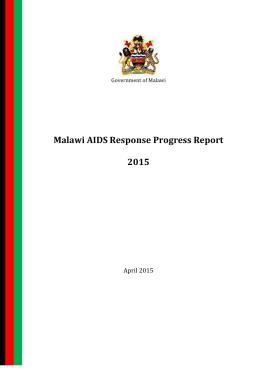Malawi AIDS Response Progress Report - 2015
Malawi AIDS Response Progress Report - 2015
The HIV epidemic in Malawi has evolved, since the first case was diagnosed in 1985, to become one of the major causes of mortality and has placed tremendous demands on the health system and the economy. The epidemic has affected all sections of society – children, youths, adults, women and men. The country’s response to this epidemic has also evolved over the years from a health sector led response to a multi-sectoral one coordinated by one national authority, one strategic framework and one monitoring and evaluation framework. The response to the epidemic has been improving in tandem with increase in availability of reliable and comprehensive data, which has enabled the country to sharpen its focus on the key HIV transmission areas and populations in order to reduce new
infections.
In June 2011, Malawi’s President joined other Heads of State and Government to review progress achieved in realizing the 2001 Declaration of Commitment on HIV and AIDS and the 2006 Political Declaration on HIV and AIDS. This High Level Meeting approved the UNAIDS Strategy ‐ Getting to Zero 2011‐2015. The leaders expressed concern regarding the inability of majority of low‐ and middle‐income countries to meet universal access to HIV treatment targets despite the major achievement of expansion in providing access to anti-retroviral treatment. Concern was also expressed that the number of new HIV infections was outpacing the number of people starting HIV treatment by a factor of two to one.

